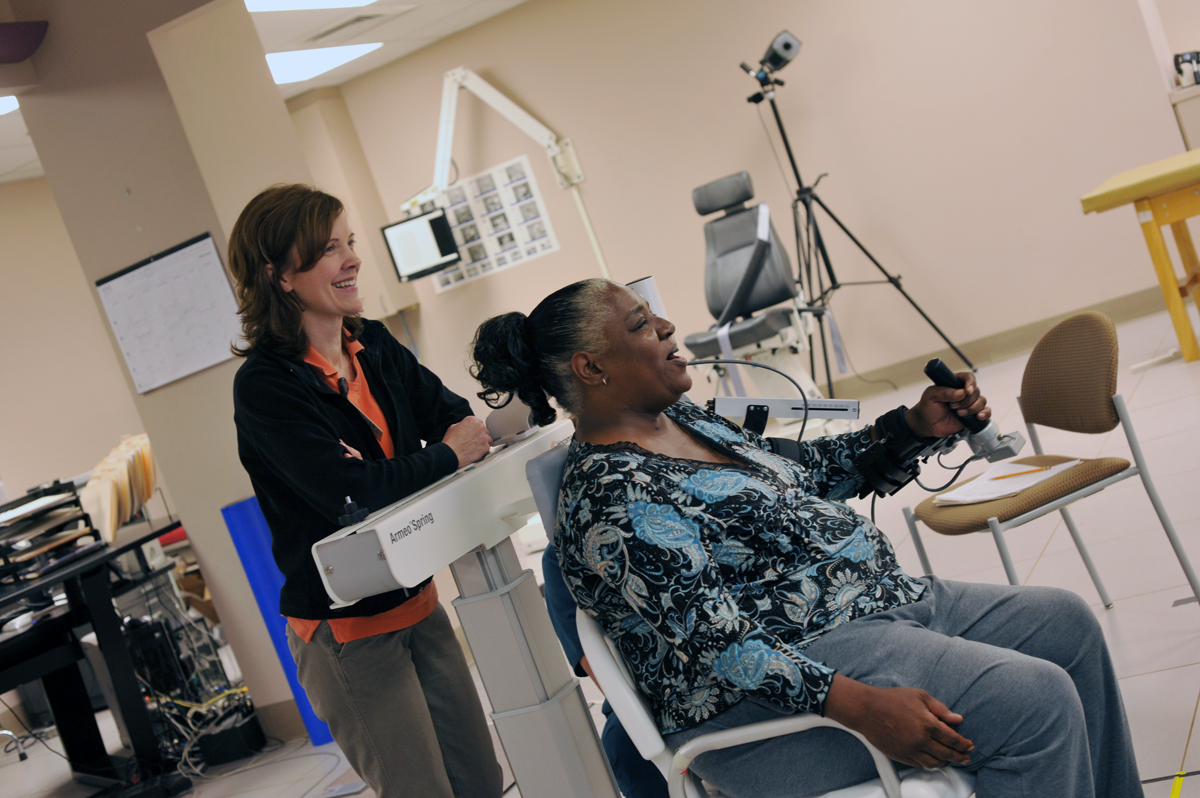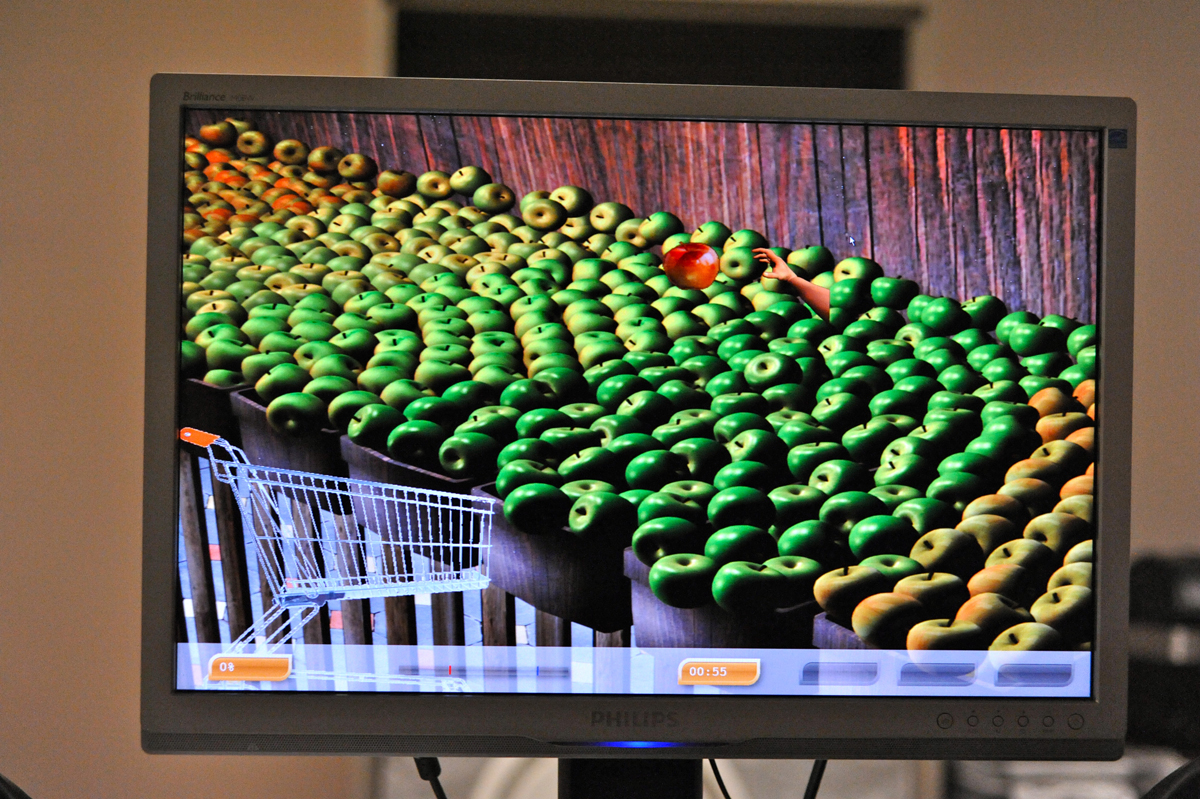To watch a video of this therapy, go to the MethodistRehabMS YouTube channel.
JACKSON—Fannie Nelson of Jackson slips her left arm into a robotic exoskeleton, wraps her fingers around a handgrip and begins firing at a flock of chickens flying across a computer screen.
It looks like a scene from a futuristic video arcade, but at play here is the hard work of rehab. Armeo®Spring therapy is helping the 50-year-old regain function in her once paralyzed left arm.
Methodist Rehabilitation Center in Jackson recently became one of only six centers in the Southeast – and the only one in Mississippi – to offer the innovative therapy. The system pairs an assistive movement device with a virtual reality training program to help patients with arm paralysis or weakness due to stroke, spinal cord and brain injuries and other neurological disorders.
Methodist Rehab occupational therapist Jenn Sivak said candidates for the therapy must have some active arm movement. “It will not move your arm for you,” she said. But the exoskeleton can make movement much easier by off-loading the weight of the arm. That makes the therapy a good fit for Nelson, who was left with a largely immobile shoulder following an April, 2010 stroke.
“Her biggest problem was with elevating her left shoulder or raising her arm above shoulder height,” Sivak said. “Initially, we took some weight off that left arm to make it easier for her to do activities. But within about a month, we were able to take all the weight compensation away.”
Made by the Switzerland-based Hocoma company, the Armeo®Spring system consists of a robotic exoskeleton on wheels that can be easily adjusted to fit either arm, along with a computer monitor and screen on a rolling cart.
“It’s completely mobile so you can take it to therapy rooms or the patient’s room,” said biomedical engineer Charla Howard, a research associate at Methodist Rehab. “And you can use it with or without a wheelchair.”
The system is preloaded with an extensive library of game-like movement exercises. Many mimic everyday activities like cracking eggs over a skillet or cleaning a stove with a sponge. Therapists adjust the parameters of the game to address problems related to a patient’s range of motion, strength or gross motor coordination.
The equipment also detects and tracks even trace amounts of movement and function, objective measures which may help MRC researchers develop treatment protocols for different types of patients.
Dr. Dobrivoje Stokic, administrative director of research at Methodist Rehab, said purchasing a system that could be used for both patient care and research seemed a good use of grant money recently received from the Ameristar Vicksburg Workplace Campaign and the Craig H. Neilsen Foundation.
“The late Ameristar founder Craig Neilsen was a quadriplegic who knew the importance of supporting promising therapies for people with paralysis,” Dr. Stokic said. “When we saw how the Armeo®Spring can help people whose arms have been severely weakened by spinal cord injury, stroke or brain injury, we knew it would fit well in our program.”
Dr. Stokic said the Armeo®Spring fosters better recovery by focusing on three main principles of rehab. “It allows patients to practice meaningful, life-like activities, to perform high repetitions of specific movements and to be actively involved in finding solutions for tasks presented during therapy,” he said.
Of course, it doesn’t hurt that the therapy is also more entertaining than traditional arm therapies, such as stacking cones or clamping clothespins. “Patients are more engaged and put out more effort,” Howard said. ”They see a score and they want to do well.”
“I love it,” Nelson said. “It has some challenging games, and I’m trying to win.”
The system records each patient’s speed and accuracy at varying levels of difficulty. But Nelson keeps track of her progress by the number of activities she can now reclaim -- like being able to lift a clothes basket.
“The other day she came in and said: ‘I went to the Laundromat,’” Sivak said. “I don’t think other people would have been quite so excited.”
But for Nelson, there’s joy to be found in every act of independence. “It can be rewarding and motivating when you do better,” she said. And she’s grateful for the MRC staff and services that have helped her recover.
“These people gave me my life back,” she said. “I didn’t think I was going to make it. I thought I was in doomland, and they brought me back. I came here not able to feed myself, dress myself or walk. And baby when I left here, I was doing all of the above.”
Candidates for Armeo®Spring therapy need some active movement in their impaired shoulder and elbow in order to qualify for the therapy. For more information, leave your contact information at 601-364-3567 and a Methodist Rehab Research Department staff member will get in touch with you.
<!-- Place this tag where you want the +1 button to render -->
<g:plusone></g:plusone>


